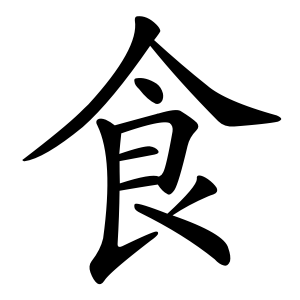Top Qs
Timeline
Chat
Perspective
Radical 184
Chinese character radical From Wikipedia, the free encyclopedia
Remove ads
Radical 184 or radical eat (食部) meaning "eat" or "food" is one of the 11 Kangxi radicals (214 radicals in total) composed of 9 strokes.


In the Kangxi Dictionary, there are 403 characters (out of 49,030) to be found under this radical.
食 is also the 185th indexing component in the Table of Indexing Chinese Character Components predominantly adopted by Simplified Chinese dictionaries published in mainland China, with the simplified left component form 饣 and its traditional form 飠 listed as its associated indexing components.
Remove ads
Evolution
- Oracle bone script character
- Bronze script character
- Large seal script character
- Small seal script character
Derived characters
Remove ads
Variant forms
Summarize
Perspective
This radical character has different forms in different languages when used as an individual character and as a component.
Traditionally, when used as an individual character, its third stroke is printed as either a horizontal line (食) or a vertical line (食), but more often written as a slanted dot (食); when used as a left component, it is usually printed as 𩙿 and written as 飠 in regular script.
In China, xin zixing adopted the handwritten form 食 and 飠 and applies it also to printing typefaces. This change is applied chiefly to Traditional Chinese publications in mainland China; the left component form 飠 was already replaced by the simplified form 饣 prior to the printing typeface reform. Taiwan's Standard Form of National Characters and Hong Kong's List of Graphemes of Commonly-Used Chinese Characters use 食 and 飠 (the third stroke is horizontal) as the standard forms, while other alternative forms (e.g. 食/𩙿, 食/飠) are still rather prevalent in publishing.
In modern Japanese, 食 (third stroke is horizontal) and 𩙿 are seen as the traditional/orthodox forms. The shinjitai reform changed the third stroke in 食 as an individual character or as a non-left component to a short horizontal line (食); changed the left component form 𩙿 to 飠. In principle, these changes apply only to jōyō kanji (more specifically, jōyō kanji before 2010 revision; some characters added in 2010 were not simplified); the traditional form is used for hyōgai kanji.
Literature
- Fazzioli, Edoardo (1987). Chinese calligraphy : from pictograph to ideogram : the history of 214 essential Chinese/Japanese characters. calligraphy by Rebecca Hon Ko. New York: Abbeville Press. ISBN 0-89659-774-1.
External links
Wikimedia Commons has media related to Radical 184.
Wikiwand - on
Seamless Wikipedia browsing. On steroids.
Remove ads





